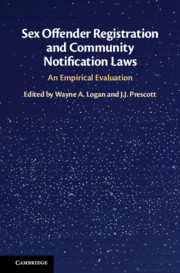Book contents
- Sex Offender Registration and Community Notification Laws: An Empirical Evaluation
- Sex Offender Registration and Community Notification Laws
- Copyright page
- Contents
- Contributors
- Preface
- Acknowledgments
- 1 Origins and Evolution
- 2 Variations in the Structure and Operation of SORN Systems
- 3 Registries and Registrants:
- 4 Law Enforcement and SORN
- 5 The Public and SORN Laws
- 6 The Ancillary Consequences of SORN
- 7 Offenders and SORN Laws
- 8 Integrating the Etiology of Sexual Offending into Evidence-Based Policy and Practices
- 9 Juvenile Registration and Notification Are Failed Policies That Must End
- Conclusion
- Index
- References
6 - The Ancillary Consequences of SORN
Published online by Cambridge University Press: 11 June 2021
- Sex Offender Registration and Community Notification Laws: An Empirical Evaluation
- Sex Offender Registration and Community Notification Laws
- Copyright page
- Contents
- Contributors
- Preface
- Acknowledgments
- 1 Origins and Evolution
- 2 Variations in the Structure and Operation of SORN Systems
- 3 Registries and Registrants:
- 4 Law Enforcement and SORN
- 5 The Public and SORN Laws
- 6 The Ancillary Consequences of SORN
- 7 Offenders and SORN Laws
- 8 Integrating the Etiology of Sexual Offending into Evidence-Based Policy and Practices
- 9 Juvenile Registration and Notification Are Failed Policies That Must End
- Conclusion
- Index
- References
Summary
Chapter 6 explores the broad range of ancillary consequences that stem from registration and notification laws. These consequences disrupt nearly every facet of daily life for registrants, their families, and their communities. The chapter begins with the most acutely felt consequences – the difficulty registrants experience finding jobs and housing. Since locating employment and housing is critical to successful reentry, the negative effects of SORN laws on both inhibit registrants’ ability to reintegrate. These difficulties have also led to the spatial clustering (“ghettoization”) of registrants. Other consequences include increased vigilantism by the public and decreased property values near registrant residences. All these consequences may lead to negative secondary effects on nonsexual criminal behavior and mental health outcomes, and in turn may affect the wellbeing of the family members of registrants and the overall community. Importantly, these wide-ranging consequences may also have hydraulic effects on charging and reporting decisions. Ultimately, this chapter concludes that SORN laws’ wide-reaching deleterious effects, and their high implementation costs, outweigh their supposed benefits. As a result, it maintains that SORN laws must be tailored to higher-risk offenders and that community notification must be curtailed.
Keywords
- Type
- Chapter
- Information
- Sex Offender Registration and Community Notification LawsAn Empirical Evaluation, pp. 78 - 101Publisher: Cambridge University PressPrint publication year: 2021
References
- 1
- Cited by

